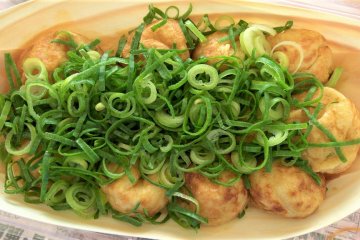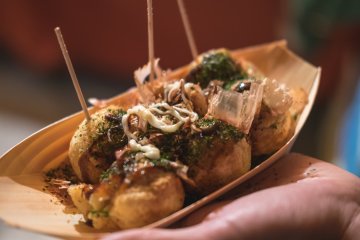Takoyaki is everywhere. From department stores to hidden away retailers under the rail tracks, wherever you go in Japan you will find somebody serving up little battered balls of diced octopus.
And for good reason too. Cooked in moulded hotplates, takoyaki are usually served in packs of 6-10, sell for around JPY300-1000 and are as close to a perfect street food as you can get. Generally brushed with mayonnaise and a Worcestershire-style sauce, the little balls are then sprinkled over with a generous serving of green laver and dried bonito flakes.
Takoyaki originated in Osaka and judging by a stroll down any Osakan street, they are certainly proud of it too. However, regional variations abound and for every stall out there, you could be forgiven for thinking that there was an equivalent number of takoyaki styles.

If you've arrived in the middle of one of Japan's humid summers, then takoyaki topped solely with green laver and ponzu sauce is an extremely refreshing delight. Nagano, one of the homes of Japanese winter, offers its takoyaki with hakusai cabbage; heatig your belly, these steaming balls of batter with flakes of bonito sizzling and dancing on top, go down well.

Lovers of history may opt for a tray of akashiyaki, an original takoyaki style made purely of batter and octopus, which is a favourite in Kobe. Purists may even go for rajioyaki, the original inspiration for the dish, made with beef instead of octopus and much more heavily soy sauce-flavoured.

No matter what style of takoyaki you choose, or where you buy it from, you're going to be hard pressed to not enjoy it. Both light and filling at the same time, the only danger with takoyaki is deciding whether you should order one more tray. If you do make an extra order, relax, everyone else does too.










